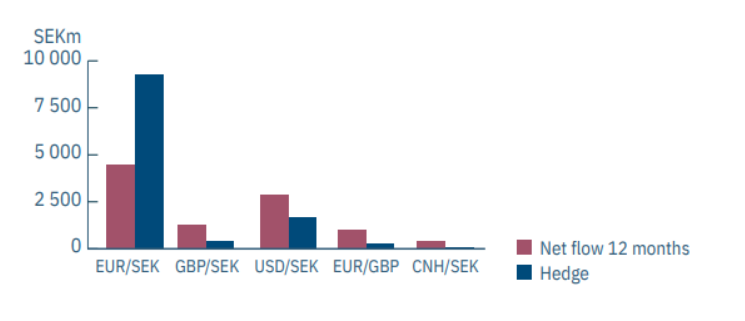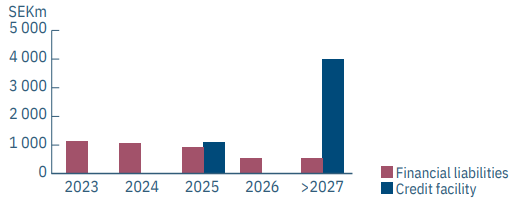Currency
Risk
The Group’s earnings are affected by fluctuations in exchange rates. Transaction exposure risk arises due to a significant portion of the Group’s sales income being in different currencies from costs. The translation exposure risk arises from the translation of foreign subsidiaries’ assets, liabilities and earnings into Swedish kronor.
Risk management
Transaction exposure. In order to reduce the impact on profit from changes in exchange rates, net flows are hedged using forward foreign exchange contracts. Net flows in euros, US dollars and pounds sterling for the coming four months are always hedged. These normally correspond to trade receivables and outstanding orders. The Board can decide to hedge flows for a longer period if this is deemed suitable in light of the products’ profitability, competitiveness and the currency situation. Currency exposure arising when investments are paid for in foreign currency is distinguished from other transaction exposure. Normally, 90–100 per cent of the currency exposure associated with major investments is hedged.
Validation of revaluations. Hedging exposure that arises when subsidiaries’ assets and liabilities are translated into Swedish kronor (known as equity hedging) is assessed on a case-by-case basis and is arranged based on the value of net assets upon consolidation. The Group’s non-current assets are mainly Swedish, with the exception of the paperboard mill in the UK, which accounts for 2 per cent of the assets. The hedges take the form of foreign currency loans or forward foreign exchange contracts.

Comment
For the next two years, expected flows in EUR/SEK are hedged at an average of 10.55. For other currencies, 4–8 months of flows are hedged.
Hedging of exposure to pounds sterling amounted to GBP 126 million at year-end. Net assets in other currencies are limited and are not usually hedged.
Interest rates
Risk
Changes in market interest rates affect the Group’s cost of borrowing.
Risk management
The fixed rate duration for the Group’s net financial debt varies over time and is decided by the Board of Directors. To limit the effects of a rise in interest rates, the interest rate on loans may be fixed, or an interest rate swap agreement may be entered into without changing the interest rate on the underlying loan.

Credit risk from financial counterparties
Risk
The risk of financial transactions giving rise to credit risks in relation to financial counterparties.
Risk management
The creditworthiness of Holmen’s financial counterparties is assessed using reputable credit rating agencies or, where a counterparty has no credit rating, the company’s own analyses. A maximum credit risk and settlement risk are established for each financial counterparty and are monitored continually. This calculation is based on the maturity and historical volatility of different types of derivatives. For cash and cash equivalents and current investments, the maximum credit risk is assessed to correspond to the nominal amount.
Comment
At 31 December 2022, the Group had outstanding derivative contracts with a nominal amount of SEK 17 billion and a net fair value of SEK 4 billion.
Liquidity and refinancing
Risk
The risk of the need for future funding and refinancing of maturing loans being required at a high cost.
Risk management
Holmen’s strategy is to have a strong financial position in order to secure room for manoeuvre when making long-term commercial decisions. The target is for net financial debt not to exceed 25 per cent of equity. Holmen’s financing usually mainly comprises bonds and the issue of commercial paper. Holmen reduces the risk of future funding becoming difficult or expensive by using long-term contractually agreed credit facilities. The Group plans its financing by forecasting financing needs over the coming years based on the Group’s budget and profit forecasts that are regularly updated.

Comment
The cash flow was strong in 2022 and net financial debt fell to SEK 2 145 million, which is equal to 4 per of equity. Financial liabilities totalled SEK 4 195 million at the end of the year, of which SEK 1 127 million are due for payment in 2023, and financial assets totalled SEK 2 050 million, of which SEK 1 935 million consist of cash and cash equivalents and short-term investments.
The Group has unutilised committed credit facilities of SEK 5 billion, of which SEK 1 billion matures in 2025 and SEK 4 billion in 2027. Both facilities include a limit stipulating that they cannot be used if net liability in relation to equity exceeds 125 per cent.
Read more

